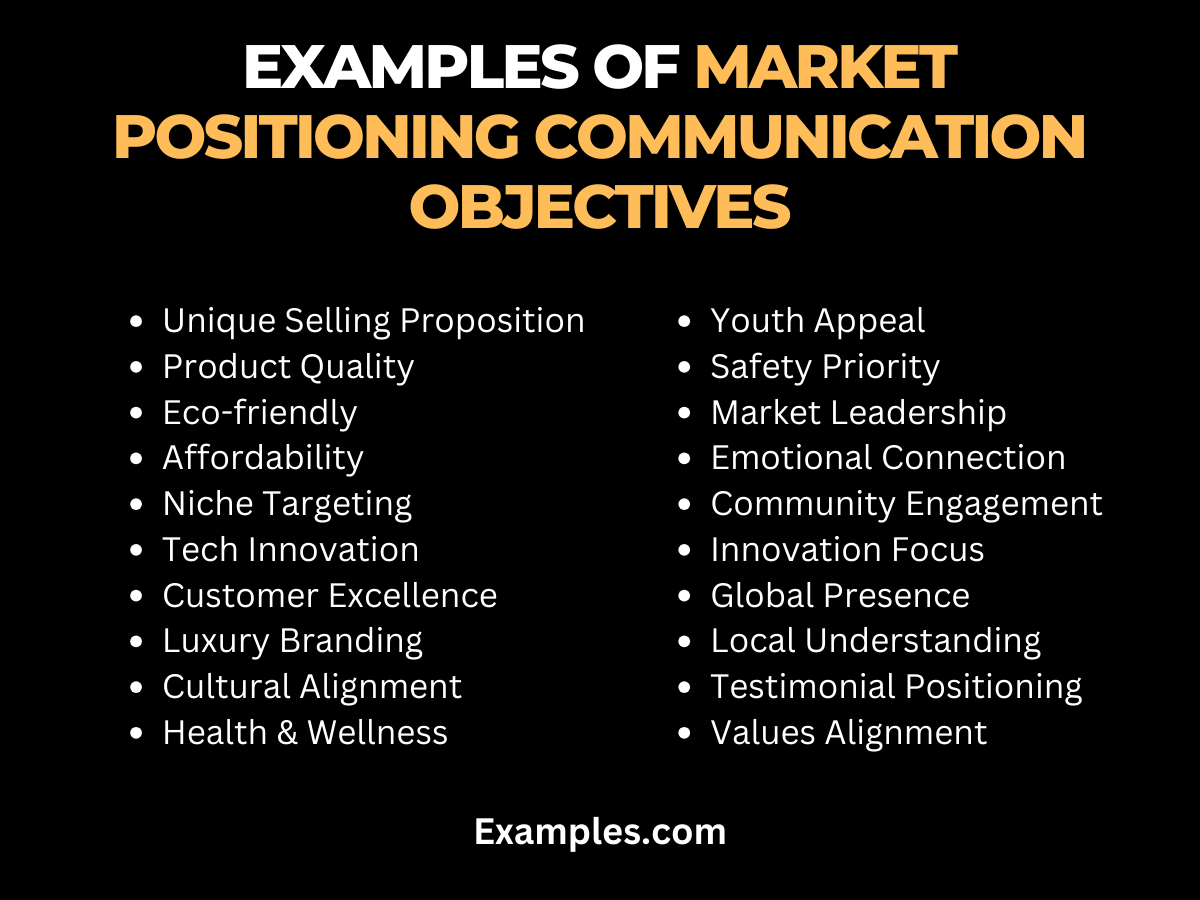19+ Market Positioning Communication Objectives Examples
Dive into the realm of Market Positioning Communication Objectives and unravel the strategies that elevate a brand’s presence in the market. This guide provides a thorough understanding of how to effectively communicate a brand’s unique value proposition, ensuring that it resonates with the target audience. It’s not just about standing out; it’s about positioning your brand in a way that aligns with customer expectations and market trends. Embrace these objectives to craft a compelling narrative that captivates and engages.
What are the Market Positioning Communication Objectives?

Market Positioning Communication Objectives focus on strategically placing a brand in the minds of consumers. These objectives revolve around differentiating a brand from competitors, emphasizing unique selling points, and creating a lasting impression that influences purchasing decisions.
What is the Best Example of Market Positioning Communication Objectives?

A prime example is Apple Inc., which positions itself as a leader in innovation and quality. Through targeted messaging and product presentation, Apple successfully communicates its superiority in technology, design, and user experience.
20 Examples of Market Positioning Communication Objectives

Market positioning communication objectives focus on strategically placing a brand in the market to differentiate it from competitors. These objectives aim to establish a unique brand identity, resonate with target audiences, and influence consumer perceptions. Effective positioning through communication leverages a brand’s strengths, aligns with customer values, and creates a lasting impression in the competitive marketplace.
- Highlighting Unique Selling Proposition (USP): Communicating what sets the product apart.
Example: “Our software offers unique privacy features unmatched in the market.” - Emphasizing Product Quality: Positioning the brand as a symbol of quality.
Example: “Experience the luxury and reliability of our handcrafted watches.” - Eco-friendly Positioning: Promoting environmental responsibility.
Example: “Join us in our journey towards sustainability with our eco-friendly packaging.” - Affordability Messaging: Positioning as a cost-effective solution.
Example: “Get the best value for your money with our affordable range.” - Targeting Niche Markets: Focusing on specific consumer segments.
Example: “Our fitness gear is specially designed for professional athletes.” - Promoting Technological Innovation: Showcasing cutting-edge technology.
Example: “Step into the future with our AI-powered home appliances.” - Emphasizing Customer Service Excellence: Highlighting superior customer support.
Example: “We’re not just selling products, we’re offering a 24/7 support experience.” - Luxury Brand Positioning: Communicating exclusivity and prestige.
Example: “Indulge in the opulence of our premium skincare range.” - Cultural Resonance: Aligning with cultural values or trends.
Example: “Our fashion line celebrates the vibrant heritage of local artisans.” - Health and Wellness Focus: Positioning around health benefits.
Example: “Our organic food products contribute to a healthier lifestyle.” - Youth-Oriented Positioning: Appealing to younger demographics.
Example: “Stay ahead in style and tech with our youth-centric gadgets.” - Safety First Messaging: Emphasizing product safety.
Example: “Safety and reliability are at the heart of our automotive engineering.” - Positioning as a Market Leader: Conveying industry dominance.
Example: “Join the ranks of professionals choosing the market leader in software solutions.” - Emotional Connect: Building an emotional relationship with the brand.
Example: “Our brand is more than a product; it’s a part of your life story.” - Community Engagement: Highlighting community involvement.
Example: “We’re more than a brand; we’re a community partner in growth.” - Pioneering Spirit: Positioning as an innovator.
Example: “Innovate with us as we redefine industry standards.” - Global Outlook: Communicating a worldwide presence.
Example: “Our global footprint empowers us to bring you the best.” - Local Focus: Emphasizing local market understanding.
Example: “Our products are tailored to meet local tastes and preferences.” - Positioning through Customer Testimonials: Using real-life stories.
Example: “Hear from our satisfied customers about their transformative experiences.” - Value-based Positioning: Aligning with consumer values.
Example: “Our commitment to ethics and fairness is unwavering in every product.”
Why You Need a Market Positioning Communication Objectives?
- Clarifies Brand Identity: Establishing clear communication objectives in market positioning helps crystallize your brand’s identity, ensuring it resonates with the target audience.
- Differentiates from Competitors: Effective communication objectives enable your brand to stand out in a crowded market by highlighting unique value propositions.
- Guides Marketing Strategies: They serve as a roadmap for all marketing activities, ensuring consistency and focus in messaging.
- Enhances Customer Understanding: Helps in communicating the brand’s role and relevance in the customers’ lives, fostering deeper connections.
- Boosts Brand Loyalty: Clear positioning through communication builds stronger brand loyalty as customers clearly understand what the brand stands for.
- Informs Product Development: Communication objectives rooted in market positioning inform product development, aligning offerings with customer expectations and market needs.
Importance of Market Positioning Communication Objectives
- Targets Ideal Customers: Helps in crafting messages that appeal directly to the core demographic, increasing marketing effectiveness.
- Maximizes Marketing ROI: By focusing on key messages, it maximizes the return on investment in marketing campaigns.
- Builds Brand Consistency: Ensures consistent brand messaging across all platforms, essential for building brand recognition and trust.
- Facilitates Market Adaptation: Allows brands to adapt their messaging based on market feedback and changing trends.
- Strengthens Competitive Advantage: A well-defined communication strategy in market positioning can become a significant competitive advantage.
- Supports Long-Term Growth: Solidifies a brand’s position in the market, paving the way for sustainable growth.
Goals for Market Positioning Communication Objectives
- Increased Brand Awareness: To make more people aware of the brand and its unique position in the market.
- Customer Retention and Loyalty: To foster a loyal customer base by consistently reinforcing the brand’s value proposition.
- Effective Communication of USP: To clearly communicate the brand’s unique selling points to differentiate from competitors.
- Market Share Growth: To expand market share by positioning the brand as a leading choice in its category.
- Enhanced Customer Perception: To shape and improve how customers perceive the brand.
- Alignment with Business Objectives: To ensure that communication strategies align with overall business goals and objectives.
Elements of Market Positioning Communication Objectives
- Target Audience Identification: Clearly defining who the brand is communicating with.
- Unique Selling Proposition (USP): Articulating what sets the brand apart.
- Key Messaging: Developing core messages that communicate the brand’s position effectively.
- Consistency Across Channels: Ensuring uniform messaging across all communication platforms.
- Feedback Mechanisms: Incorporating ways to gather customer feedback to refine positioning strategies.
- Alignment with Marketing Mix: Ensuring that communication objectives complement other elements of the marketing strategy (product, price, place, promotion).
Market positioning communication objectives is essential for brand success. By aligning with customer values, leveraging unique strengths, and crafting compelling messages, businesses can differentiate themselves effectively. Use these tips to create impactful strategies that resonate with your target audience, ensuring a competitive edge in the dynamic marketplace.



